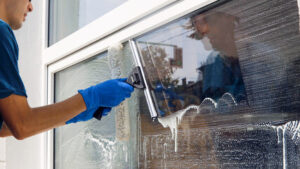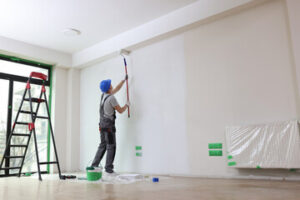Keeping your windows clean is one of the most important things you can do to keep your home looking great. It will also help prevent the build-up of dirt and hard water minerals that can cause staining.

Landlords often include window cleaning services as part of their regular maintenance schedule for apartment complexes and high-rise buildings. Tenants may be responsible for this task themselves, depending on their lease agreement. Keep reading the article below to learn more about Exterior Window Cleaning Service.
The towering beauty of skyscrapers is often a centerpiece in the urban landscape. These architectural marvels are meant to evoke awe in those who see them and serve as monuments to human innovation and creativity. Unfortunately, dust and pollen can obscure their true splendor, creating a grimy exterior that can diminish the building’s impact on observers and occupants alike. Fortunately, high rise window cleaning services can help to restore these structures to their former glory.
It is important to note that high-rise buildings require specialized equipment and workers to clean them properly. In general, a building is considered a high-rise under the 1968 Building Code if it is 75 feet or taller above the lowest level where fire department access is permitted. However, the actual height of a building can vary greatly depending on its design and construction materials.
Typically, high-rise windows are cleaned by using repelling systems. These are specially designed tools that allow the worker to safely reach and clean each individual window without having to leave the safety of a lift or other platform. In addition to these repelling systems, high-rise building cleaners may also utilize ladders and a device called a “bosun’s chair” to reach hard-to-reach areas.
Working at such great heights can be a dangerous job. Falls are the leading cause of injury for workers in this profession, and while there are measures in place to prevent accidents, they can still occur. To mitigate these dangers, workers should undergo regular training to ensure that they are utilizing all appropriate safety equipment. In addition, the equipment used should be inspected on a regular basis to ensure that it is in good condition and free from wear and tear.
Lastly, the best way to protect against accidents is to have a clear understanding of what each worker’s duties are and how they fit into the larger picture. High-rise window cleaning is a detailed, complex job that requires a great deal of experience and skill to complete correctly. Therefore, it is important to partner with a professional service that has the proper knowledge and expertise to tackle the task efficiently.
Window Cleaning for Commercial Buildings
Commercial windows make a significant impact on the image of a business, reflecting professionalism and attention to detail. They allow ample natural light to enter the building, which enhances productivity and creates an inviting atmosphere for clients and customers. Dirty windows can leave a negative impression and deter potential customers, so it’s important to keep them clean.
Many NYC landlords include window cleaning in their regular building maintenance schedules. This is particularly true for high-rise buildings, which require specialized equipment to access and clean exterior windows at heights over 50 feet. Professional cleaners are trained in ladder safety and use a controlled descent system to safely clean building facades and window surfaces. Regular cleanings remove dirt and pollutants that obscure visibility and degrade glass over time.
In addition to enhancing the appearance of a building, cleaning commercial windows provides several other benefits for property managers. For example, it increases tenant satisfaction and decreases turnover rates. This reduces expenses associated with finding new tenants and rehabilitating vacant spaces. Clean windows also help maintain optimal energy efficiency by maximizing sunlight and reducing the need for artificial lighting and heating.
Before starting the actual cleaning, it’s best to start by removing dust and cobwebs from the frames, sills, and tracks. You can use a vacuum cleaner with a brush attachment or a soft bristle brush to get rid of these particles, which will prevent them from spreading onto the glass during the cleaning process.
Once the frames are free of debris, spray them with cleaner and let it soak in for a few minutes. Then, using a cloth or cotton swabs, wipe the surface and inside corners of the frame. Finally, use a dry cloth to wipe off any remaining cleaner and remove any stubborn deposits.
Regular cleaning of commercial windows and other exterior components helps to avoid expensive restoration work in the future. Without regular cleaning, dirt and pollutants build up on the glass’s surface, causing stains, blurriness, and pigmented spots. These contaminants can also etch into the glass, creating permanent damage that requires costly restoration or replacement.
Window Cleaning for Multi-Story Buildings
In a multi-story building, the windows are a key component of the exterior’s aesthetic, but are also often difficult to clean. Unlike interior windows, exterior windows are exposed to harsh weather and other environmental factors that can cause them to become dirty more quickly. For this reason, a professional window cleaning service is usually needed for multi-story buildings.
Cleaning services for high-rise buildings need to utilize a variety of tools and equipment that can reach a higher elevation. These include ladders, telescopic poles, and other specialized cleaning systems. Additionally, a high-rise cleaning service should be experienced in the use of rope access techniques, such as rope descent systems (RDS). These are a great choice for tall buildings and can provide cleaners with the flexibility they need to tackle challenging windows and hard-to-reach areas.
The specialized equipment used by high-rise cleaners can be more expensive than standard cleaning supplies, but the investment is well worth it. By utilizing the proper cleaning equipment and addressing safety concerns, high-rise windows can be cleaned safely and efficiently.
Ladders are an essential tool for window cleaning, but the process can be dangerous when done incorrectly. To minimize the risk, high-rise cleaners must follow all ladder safety guidelines, including positioning the ladder properly and maintaining three points of contact at all times. Additionally, they should always wear appropriate safety gear and use a harness when working at a high elevation.
To avoid accidents and injuries, it’s important for window cleaners to train extensively before performing a job at a high elevation. Training focuses on using the right techniques, preparing for common obstacles, and developing an emergency response plan. Additionally, it’s important for high-rise cleaners to keep their equipment in good condition. Regular maintenance helps ensure that all safety features are functioning properly and that the ladders can handle the load of a window cleaner.
Providing a high-quality exterior window cleaning service is an important part of any building maintenance regimen. Regular and deep cleaning can help to extend the life of a building’s windows, which in turn enhances its overall value and appeal. Whether you’re looking for window cleaning services for commercial or residential buildings, Valcourt can help you develop an effective maintenance program that addresses the unique needs of your building.
Window Cleaning for Townhouses
The exterior of townhouses, single family homes, and penthouses need regular window cleaning to keep them looking clean and pristine. As with other types of residential buildings, a professional cleaner is equipped, trained, and experienced in washing the windows of these properties. In addition to the cleaning service, a window washer can also take care of other outdoor maintenance tasks like pressure washing, gutter cleaning and protection, and lighting fixture cleaning.
For many building owners and managers, the question of who should be responsible for exterior window cleaning is a source of debate. Ultimately, this is a decision that should be based on health and safety concerns. For example, cleaning the windows of a multi-story building requires the use of high-reaching equipment that can be difficult to handle without proper training and experience. Hiring an outside company to do the job is a safe and convenient option that can prevent both personal injury and property damage.
In smaller buildings and townhouses, it may be easier to determine responsibilities for maintenance tasks. For example, a well-drafted lease agreement may clearly define landlords’ and tenants’ responsibilities for maintenance and upkeep. If the lease is unclear, both parties should be able to find clarity on this issue by seeking clarification from their landlord.
A tenant or homeowner should never attempt to clean their own windows unless they are completely comfortable using high-reaching equipment and are familiar with the equipment’s operation. Otherwise, the risk of injury or property damage is high, especially if the windows are on an upper story of a building.
Moreover, the squeegee used to remove water from the glass needs to be properly fitted to the panes and maintained in good condition. It is recommended to start at the top of the window and work in straight, singular motions. This will help to ensure that no watermarks or streaks are left behind on the windowsill or brick. After squeegeing, it is important to wipe down the squeegee with a dry cloth.
In some cases, it is a better option for homeowners to organize with their neighbors to share the cost of hiring a professional window cleaner. This way, they can have the outside of their apartment cleaned more regularly for a much cheaper rate than having to pay for a cherry picker to come and clean their individual apartments every 6 months.


